Middlesbrough, Stockton and Thornaby Electric Tramways
History
Middlesbrough, Stockton and Thornaby Electric Tramways were wholly owned and directly operated by the rather grandly titled Imperial Tramways Company Ltd. This company began life in 1878 — as a London-based company — with the purchase of several tramway systems (in places as diverse as Dublin and Reading) and eventually had a railway interest as well (Corris Railway). Its first foothold on Teeside came in 1878, when it purchased a small horse tramway — the Middlesbrough and Stockton Tramways Company — which despite the name, only ever reached Newport, some two miles east of Stockton. In the 1890s, the ITCo developed plans for an electric system that would connect Middlesbrough, Stockton and Thornaby, and with this aim in mind, in 1896 it purchased another local concern — the Stockton and District Tramways Company — which operated steam trams between Norton and South Stockton (later known as Thornaby), as well as horse trams on a completely separate system in Darlington.
As a precursor to conversion to a 3ft 7in-gauge electric tramway, the Stockton lines of the S&DTCo were closed in October 1897, and the Middlesbrough and Stockton Tramways on the 24th December 1897, construction proceeding from Norton through Stockton to Middlesbrough. The last steam service probably ran on the 3rd October 1897, with new electric services commencing some nine months later on the 13th July 1898, the official opening ceremony taking place three days later. The main line ran from Norton, southwards to Stockton, before crossing the Tees via Victoria Bridge into Thornaby. From there, the line ran eastwards to Middlesbrough, then southwards to the terminus in North Ormesby. A branch line ran southwards from the centre of Middlesbrough to Linthorpe, and later on (in 1901), a branch northwards to the Clarence Ferry (from 1911, Middlesbrough Transporter Bridge). This latter extension took the system to its final size of 9.61 miles.
The tramway was very profitable, and also had the good fortune to have finished renewing all its trackwork before the outbreak of the Great War. The end of the war however brought new challenges, with all three local authorities (Middlesbrough, Stockton-on-Tees and Thornaby-on-Tees) exercising their right to purchase the lines and assets within their respective areas. The system passed out of private ownership and into public ownership on the 3rd April 1921, Middlesbrough Corporation receiving 31 tramcars, Stockton Corporation 18 and Thornaby Corporation 9; the latter two corporations operating their share of the system via a Joint Committee.
The last tram to run over former MS&TET tracks was operated by Middlesbrough Corporation on the 9th June 1934.
Uniforms
Staff working the newly inaugurated electric services were issued with double-breasted jackets with two rows of four buttons, three waist-level pockets, a breast pocket and lapels; the latter bore embroidered initials on both sides — 'MS&TET'. Caps were in a tall kepi style often referred to as a 'pillbox'; they were embellished with piping, and bore a large circular oval cloth cap badge (also piped) comprising the system initials — 'MS&TET' — above the bearer's grade, 'CONDUCTOR' or 'MOTORMAN' (probably). The kepi-style caps appear to have been replaced in the mid-Edwardian era by military-style caps with an unusually wide, tensioned crown (top); the new caps carried standard, 'off-the-shelf', script-lettering grade badges, either Motorman or Conductor. The badges were probably brass.
At some point, probably around 1910-1912, double-breasted, 'lancer-style' tunics were introduced. These new jackets had two rows of five buttons — narrowing from top to bottom — and upright collars; the latter probably bore system initials — 'M S T E T' — on both sides in individual brass letters. A new, elaborate brass cap badge was also introduced; this comprised the arms of Middlesbrough, Stockton and Thornaby above the full system title and grade — 'Motorman' or 'Conductor' — within ribbons (see below for examples).
A prominent and strikingly elaborate enamel licence was also worn by both tramcar staff; examples of 'Motorman' and 'Driver' have survived (see below), though the distinction between these remains unclear. These licences seem to have fallen out of use around 1910-1912, but were probably brought back during the Great War for use by female staff.
It is currently also unclear what uniform was worn by inspectors. Whilst a photograph (shown below) clearly shows that they were issued with double-breasted overcoats with two rows of four buttons and lapels (the latter carrying embroidered insignia of some kind), it is unclear what style of jacket was worn beneath. Caps were probably in the same style as those issued to tramcar staff, but with the grade — Inspector — in embroidered script lettering. In later years, the caps certainly bore braiding of a different colour to the cap. From around 1910 onwards, inspectors were almost certainly issued with the same pattern of elaborate brass cap badge as tramcar crews, but with their grade — 'Inspector' — in the ribbon at the bottom (see below).
In common with many UK tramways systems, the MS&TET employed women during the Great War to replace male staff lost to the armed services. It is unclear what uniform was worn, as the sole surviving photograph shows a motorwoman in a long, and very distinctive double-breasted overcoat with two rows of eight widely spaced buttons and high, fold-over collars; the latter appear not to have carried any insignia. Headgear comprised a baggy cap (possibly leather) that bore the standard three-shield brass cap badge. The surviving photo shows the subject with a markedly different licence than the examples that have survived, suggesting that the style of enamel licences was changed in later years.
Further reading
For a history of Middlesbrough-area tramways, see: 'The Tramways of Teeside' by George S Hearse; The Tramway Review, Nos 22 & 23 (p141-161); Light Railway Transport League (1957).
Images
Motormen and conductors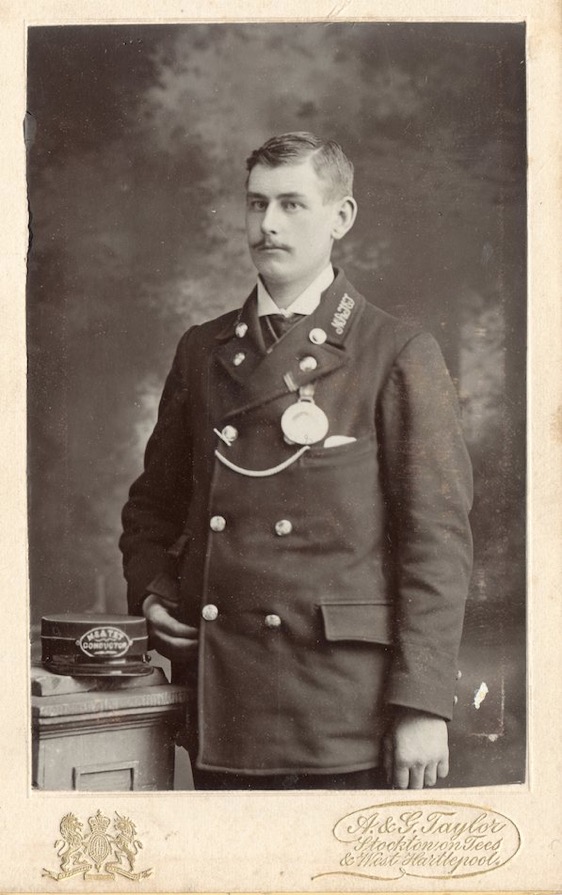
A studio portrait of an MS&TET conductor — photo undated, but more than likely taken around the time of opening, i.e., 1898. Author's Collection.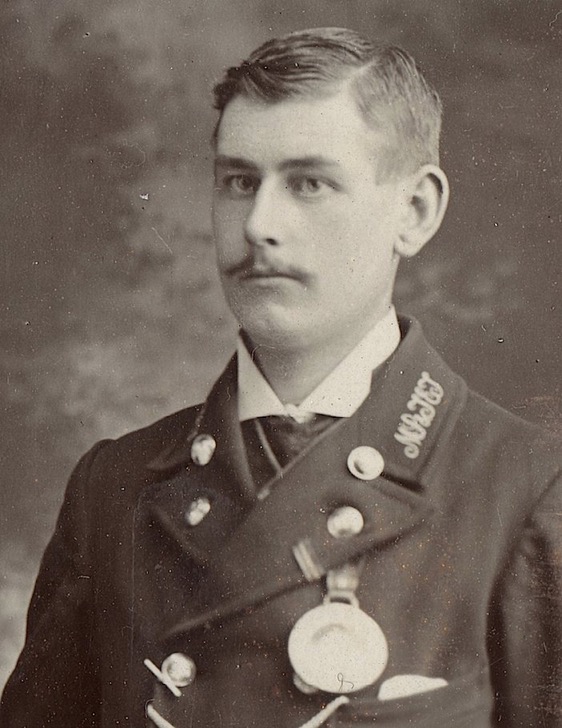
A blow-up of the above photo showing details of the collar insignia. Magnification suggests that the buttons bore script lettering, possibly 'ITCL' initials (see link).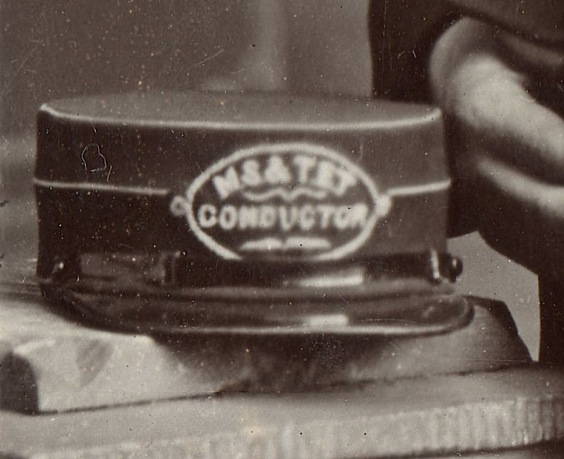
Another blow-up of the above photo showing the conductor's pill box cap and elaborate cloth cap badge.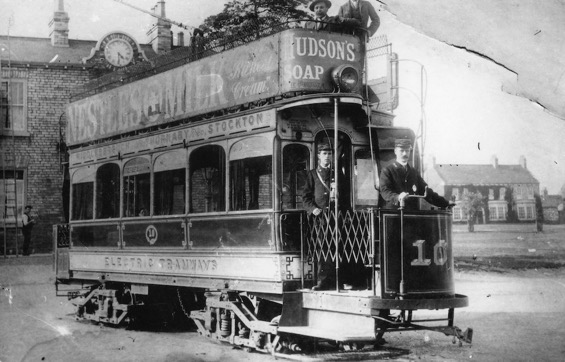
The crew of a rather pristine-looking No 10 stand at what appears to have been a favoured location for photographers, the terminus at Norton — photo undated, but given the condition of the tram, probably taken in the late 1890s. Author's Collection.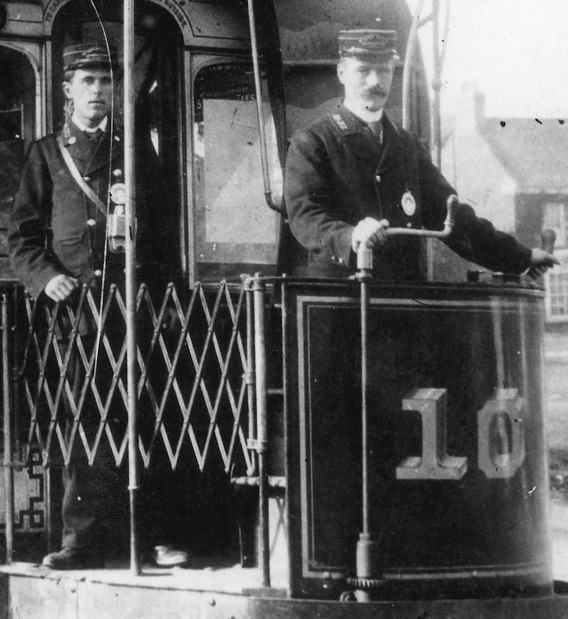
A blow-up of the above photo showing the motorman and conductor, both of whom are wearing thick serge jackets with embroidered collars and enamel licences, along with kepi-style caps.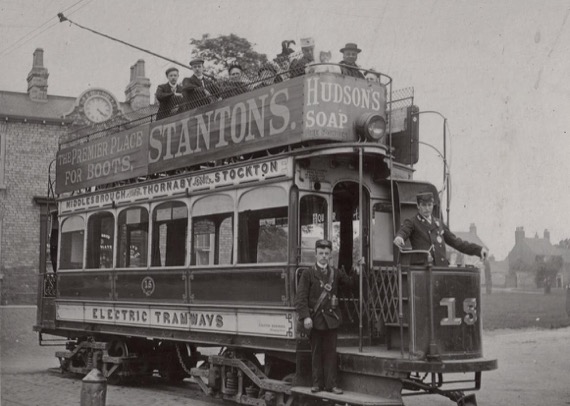
Another shot of a fairly new tram at Norton terminus, this time No 15, with Motorman G E Sidgwick at the helm — photo undated, but probably taken around the turn of the century.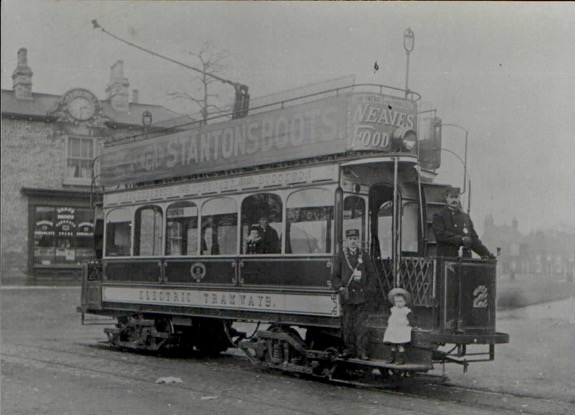
Motorman John Gunn and his conductor aboard Tramcar No 2 (once again at the Norton Terminus), along with his infant son, also called John — photo taken around 1902. With thanks to Janet Allison, grand-daughter of Motorman Gunn.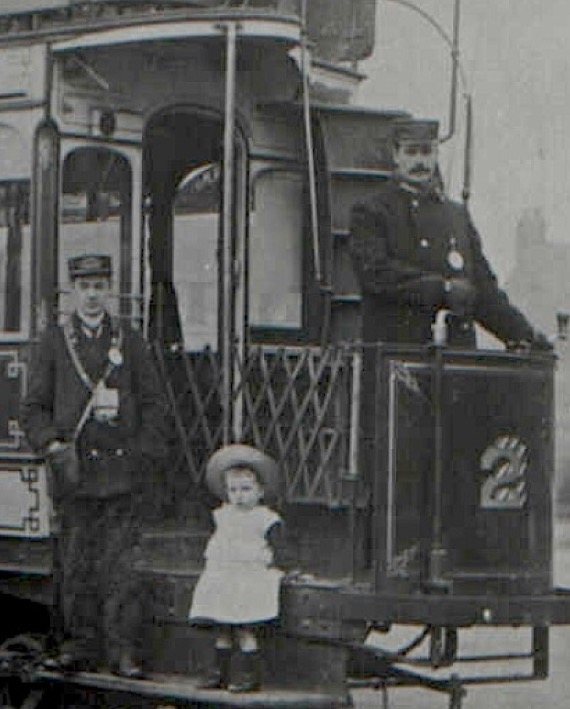
A blow-up of the above photo showing the crew.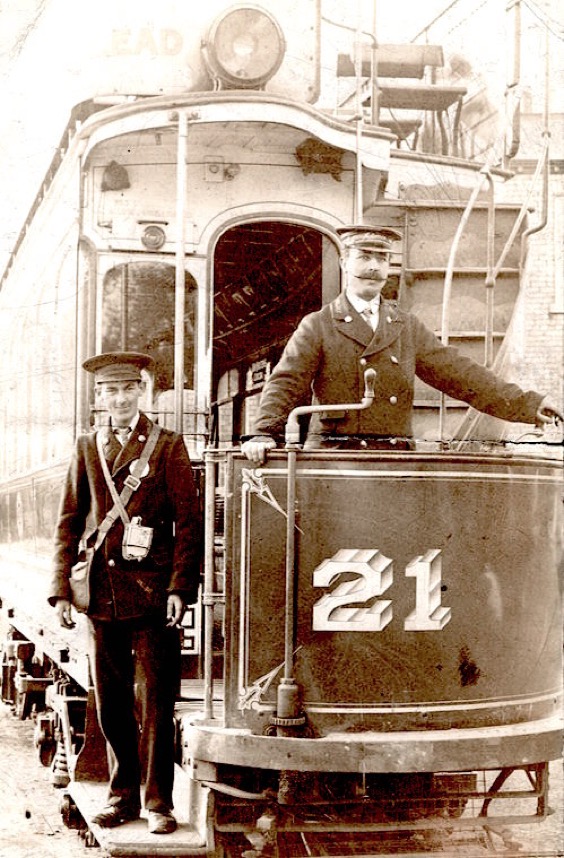
The crew of Tramcar No 21 — photo undated, but probably taken in the mid-Edwardian era. Author's Collection.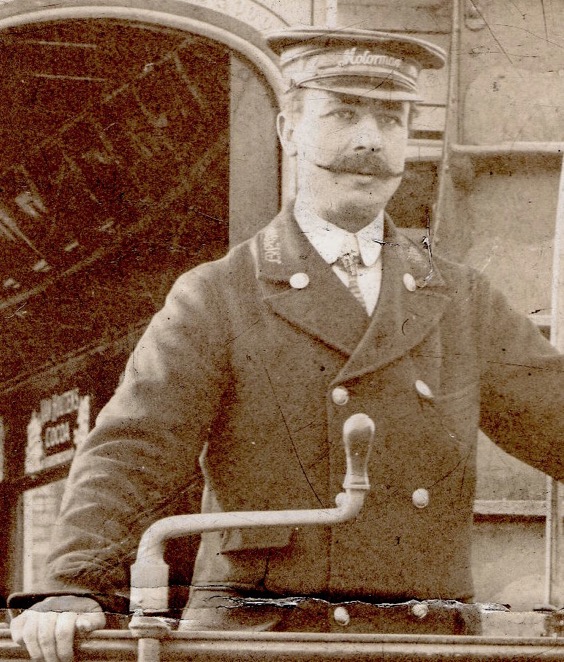
A blow-up of the above photograph showing the motorman — Tom O'Brien. By this time, the kepi-style caps had been replaced by military-style caps with a wide tensioned crown (top), and the cloth cap badge by a standard, 'off-the-shelf' grade badge.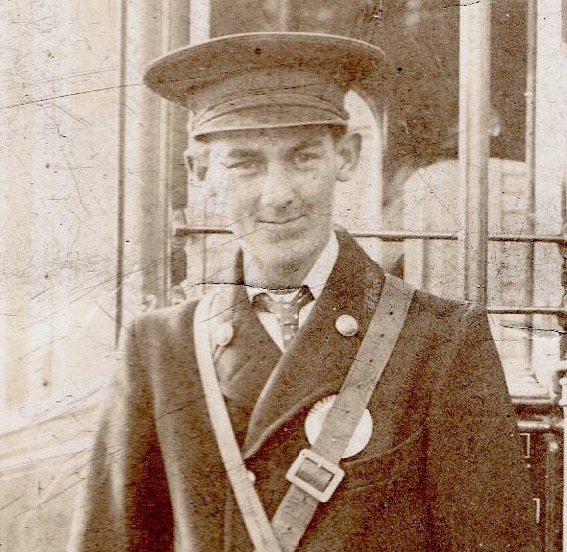
Another blow-up of the above photo, this time showing the conductor, whose cap, though difficult to discern, also bears a script-lettering grade badge: 'Conductor'.
General pattern script-lettering cap badges — Motorman and Conductor — of the type used by the MS&TETCo in the mid-to-late Edwardian era — brass.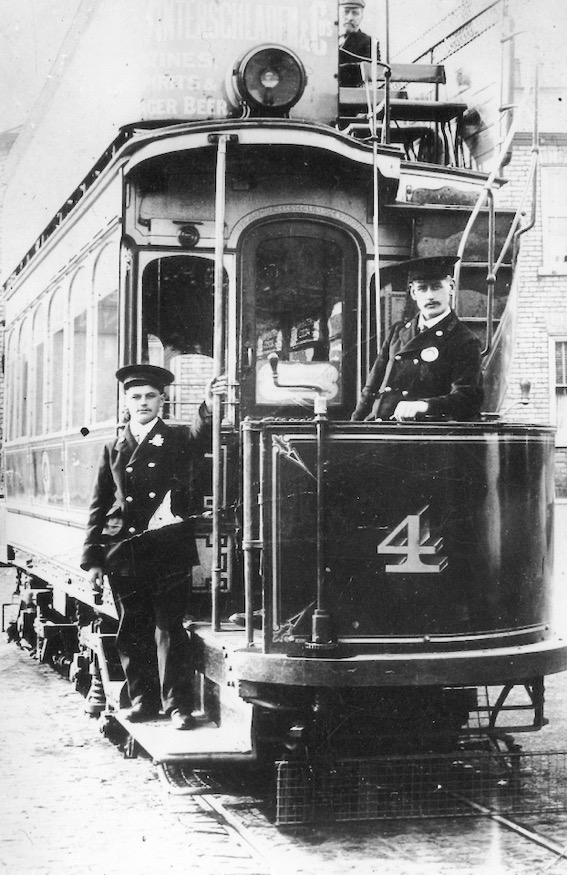
Conductor and motorman pose with Tramcar No 4 — photo undated and uncaptioned, but positively identified through the advertisement on the top deck for ‘Winterschladen & Co.’ a local purveyor and importer of wines, spirits and beers. The cap badges cannot be seen on either man, almost certainly due to the unusually wide crown (top) of the military-style caps. The conductor is wearing a large badge of some description on his left lapel, almost certainly of non-standard issue. Author's Collection.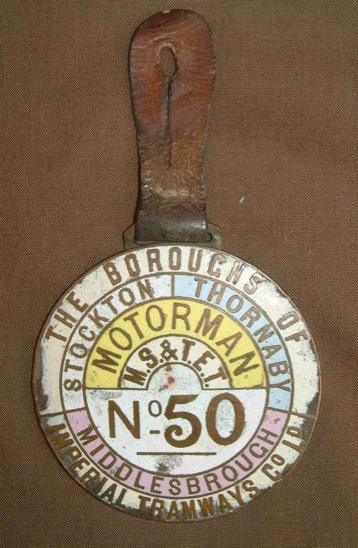
MS&TET 'Motorman' licence badge — probably used in the first decade of operation. With thanks to Gary Bayfield.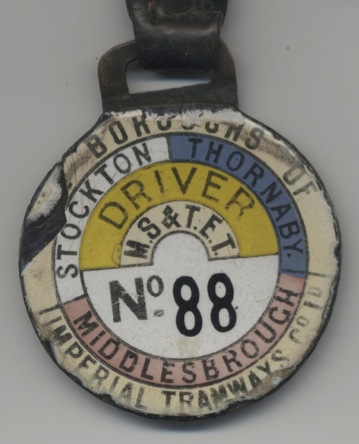
MS&TET 'Driver' licence badge — it is unclear whether this was used for motorman or for motorbus drivers, the ITCo introducing motorbus services in 1914. Author's Collection.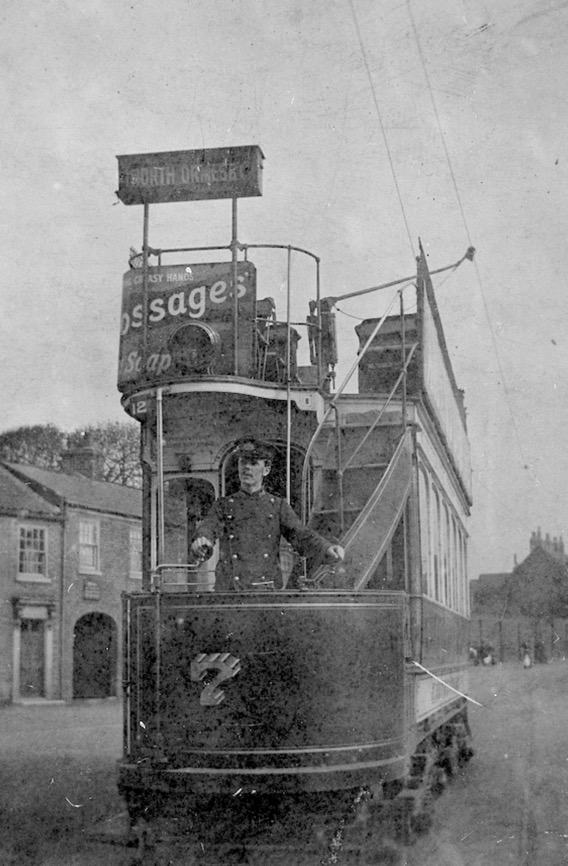
An MS&TET motorman stands ready at the controls of Tramcar No 7 — photo undated, but probably taken around 1912. With thanks to the National Tramway Museum. 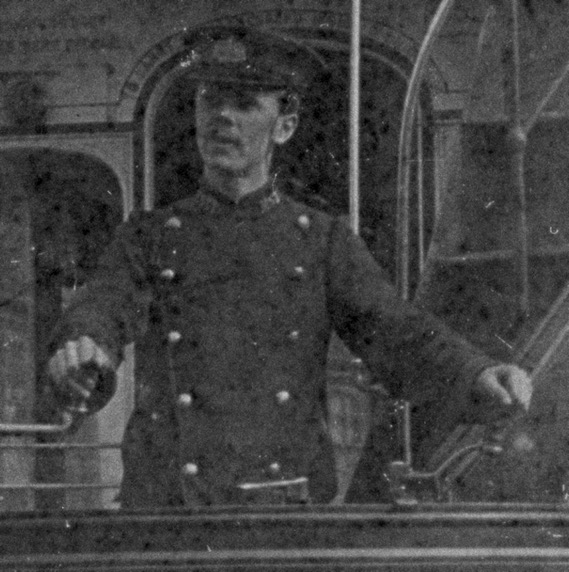
A blow-up of the above photo showing the motorman. The tunic is now in a 'lancer-style' and would appear to bear individual 'M S T E T' initials on each collar. The cap bears a new and prominent cap badge comprising the shields of Middlesbrough, Stockton and Thornaby. Neither this man nor the conductor below, are wearing a licence, suggesting that they had perhaps fallen out of use by this time.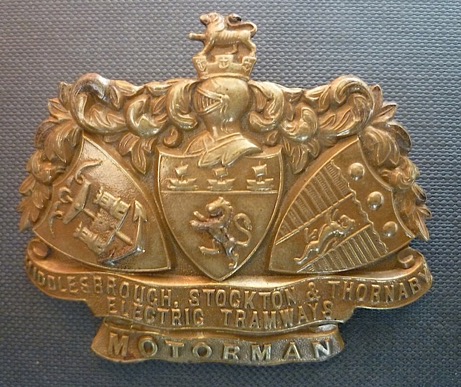
MS&TET motorman's cap badge — brass. This style of cap badge appears to have been in use from around 1910 through to municipalisation in 1921. Following the creation of Stockton and Thornaby Tramways (in 1921), a very similar cap badge was issued, but omitting the Middlesbrough shield (see link). Author's Collection. 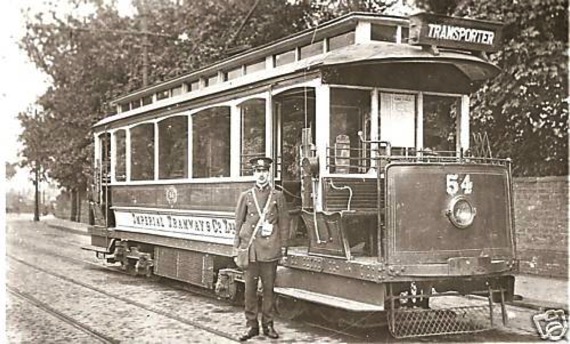
MS&TET conductor George Simpson poses for the cameraman with Tramcar No 54 at the Linthorpe terminus — photo purportedly taken circa 1912. The subject is wearing a 'lancer-style' tunic with the new elaborate cap badge. Photo courtesy of the Tramways and Light Railway Society, with thanks to David Voice.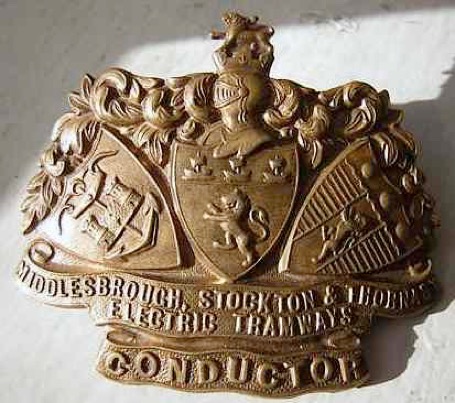
MS&TET conductor's cap badge — brass. See Ken Sequin's 'The Graphic Art of the Enamel Badge'; Thames and Hudson, 1999.
Senior staff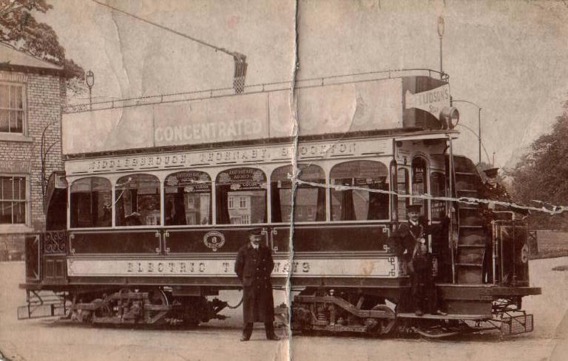
Yet another shot taken at the Norton terminus, this time of Tramcar No 8 around 1910, and including an MS&TET inspector.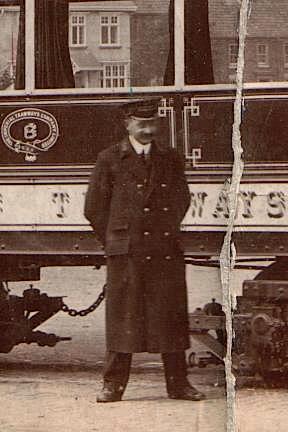
A blow-up of the above photo showing the inspector, in double-breasted overcoat with collar insignia, and with a military-style cap with what appears to be an embroidered script-lettering grade badge.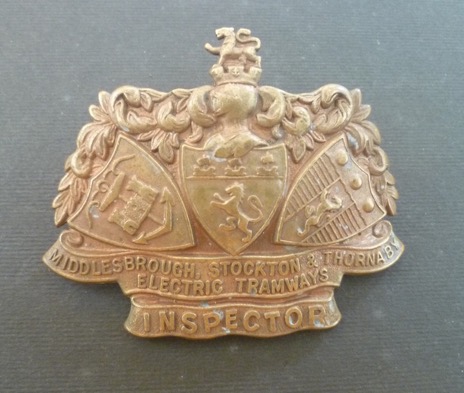
MS&TET inspector's cap badge — brass. This style of cap badge appears to have been in use from around 1910 through to municipalisation in 1921. Author's Collection.
Female staff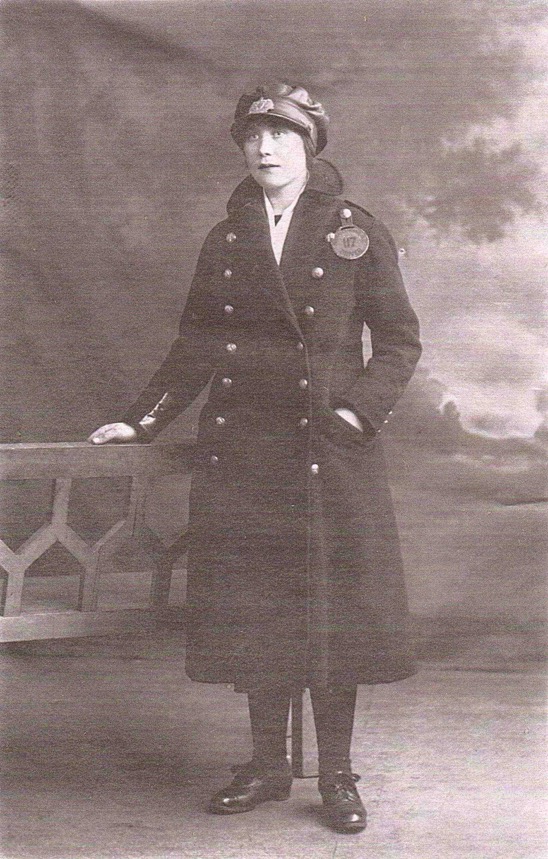
Ethel Atkinson - MS&TET Driver No 117 — photo undated, but almost certainly taken during or shortly after the Great War. Note the round licence, which is markedly different to the surviving enamel examples shown earlier. With thanks to her grand-daughter, Norma Pearson.